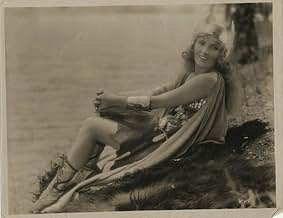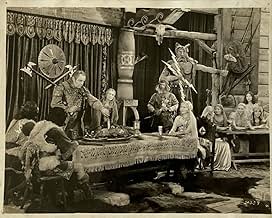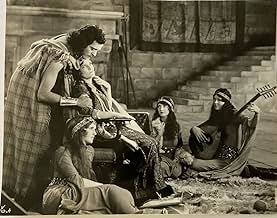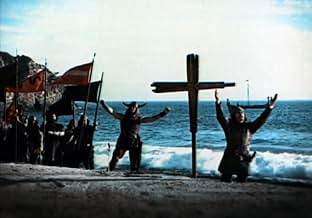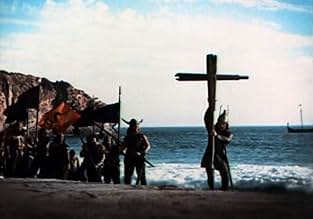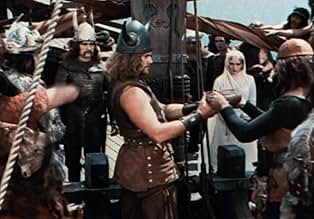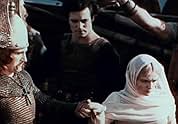Vikings compete for power and the love of a woman.Vikings compete for power and the love of a woman.Vikings compete for power and the love of a woman.
- Director
- Writers
- Stars
Anders Randolf
- Eric the Red
- (as Anders Randolph)
Harry Woods
- Egil
- (as Harry Lewis Woods)
Claire McDowell
- Lady Editha
- (as Claire MacDowell)
Iron Eyes Cody
- Indian
- (uncredited)
Frank Ellis
- Man Who Gives Sword to Alwin
- (uncredited)
Eugene McDonald
- Minor Role
- (uncredited)
Francis McDonald
- Viking Friend of Leif
- (uncredited)
Lon Poff
- Friar Slain by Vikings
- (uncredited)
Angelo Rossitto
- Viking Dwarf
- (uncredited)
Dick Sutherland
- Viking
- (uncredited)
- Director
- Writers
- All cast & crew
- Production, box office & more at IMDbPro
Featured reviews
Donald Crisp was an extremely prolific actor in sound films. What many people don't know is that he made even more silent films (as actor and director) than sound films. In The Viking, he plays Leif Ericsson, who plans his greatest adventure, to go beyond Greenland and explore for new lands.
A strikingly handsome LeRoy Mason plays Lord Alwin, an English noble. His castle is attacked by the Vikings early in the film, his family scattered, and he is made a slave.
The lovely Pauline Starke plays Helga Nilsson, who is a spunky Nordic gal who is loved by Leif, Alwin, and... well let's not give away too much of the story here.
What makes this film charming and somewhat unique is that it came at the end of the silent era, when camera technique was at its height. It is also filmed in primitive technicolor. The early technicolor process did not render true color as we know it today. The muted shades of the film actually help to make the historic subject matter of the film more remote, as though one were actually watching something that happened long, long ago.
The version of this film that I saw had sound effects, and a symphonic musical score that mixed new music with lots of Richard Wagner at climactic moments. It all worked very well.
It's amazing to me that this very entertaining film is almost unknown today.
A strikingly handsome LeRoy Mason plays Lord Alwin, an English noble. His castle is attacked by the Vikings early in the film, his family scattered, and he is made a slave.
The lovely Pauline Starke plays Helga Nilsson, who is a spunky Nordic gal who is loved by Leif, Alwin, and... well let's not give away too much of the story here.
What makes this film charming and somewhat unique is that it came at the end of the silent era, when camera technique was at its height. It is also filmed in primitive technicolor. The early technicolor process did not render true color as we know it today. The muted shades of the film actually help to make the historic subject matter of the film more remote, as though one were actually watching something that happened long, long ago.
The version of this film that I saw had sound effects, and a symphonic musical score that mixed new music with lots of Richard Wagner at climactic moments. It all worked very well.
It's amazing to me that this very entertaining film is almost unknown today.
Viking, The (1928)
** 1/2 (out of 4)
Leif Ericsson (Donald Crisp) sales off in hopes of going West of Greenland looking for uncharted land. Along the way he battles with viking queen Helga (Pauline Starke) as well as a slave (LeRoy Mason) she bought. If you're looking for a history lesson then I'd recommend you get a book because there are certainly many liberties taken with the "truth" here. However, at the same time, I've always said that you shouldn't come into a movie expecting a history lesson because a movies main goal should be to entertain you and for the most part THE VIKING is an entertaining film. It is somewhat historic because it was an all-color production that has some of the best looking 2-strip Technicolor that you're going to see. Coming at the end of the silent era we're also greeted with a soundtrack as well as several sound effects. I don't think there's any question that the main reason to see this is for the Technicolor, which is certainly very beautiful and there's also no question that MGM went all out to make sure there were plenty of colorful items in front of the camera. The look of the costumes, sets and ships are certainly beautiful to see in color and you can tell that the studio pumped up the look so they could show off all the colors. The beautiful blues of the seas were a major highlight as was the bloody red that actually happens during some of the more violent scenes including one man get stabbed as well as another getting an ax in the head. The sound effects are mainly crowd noises such as cheers but there are still enough of them to make you forget you're watching a silent movie. The actual story being told is rather weak because there's a love triangle that really goes no where and some of the alterations to history are a tad bit funny and I don't think the filmmakers were wanting you to be laughing. The three leads are decent in their roles but I'd be lying if I said any of them really stood out. There are some rather wild moments including a brief bit where the men believes there's a witch and ghost below decks and another violent fight where the Pagans go after the Christians. Fans of Technicolor will certainly want to check this out as will silent film buffs but I'd be willing to bet that the rest will find themselves bored. THE VIKING isn't perfect and it's too flawed to be a good movie but there's some entertainment to be had.
** 1/2 (out of 4)
Leif Ericsson (Donald Crisp) sales off in hopes of going West of Greenland looking for uncharted land. Along the way he battles with viking queen Helga (Pauline Starke) as well as a slave (LeRoy Mason) she bought. If you're looking for a history lesson then I'd recommend you get a book because there are certainly many liberties taken with the "truth" here. However, at the same time, I've always said that you shouldn't come into a movie expecting a history lesson because a movies main goal should be to entertain you and for the most part THE VIKING is an entertaining film. It is somewhat historic because it was an all-color production that has some of the best looking 2-strip Technicolor that you're going to see. Coming at the end of the silent era we're also greeted with a soundtrack as well as several sound effects. I don't think there's any question that the main reason to see this is for the Technicolor, which is certainly very beautiful and there's also no question that MGM went all out to make sure there were plenty of colorful items in front of the camera. The look of the costumes, sets and ships are certainly beautiful to see in color and you can tell that the studio pumped up the look so they could show off all the colors. The beautiful blues of the seas were a major highlight as was the bloody red that actually happens during some of the more violent scenes including one man get stabbed as well as another getting an ax in the head. The sound effects are mainly crowd noises such as cheers but there are still enough of them to make you forget you're watching a silent movie. The actual story being told is rather weak because there's a love triangle that really goes no where and some of the alterations to history are a tad bit funny and I don't think the filmmakers were wanting you to be laughing. The three leads are decent in their roles but I'd be lying if I said any of them really stood out. There are some rather wild moments including a brief bit where the men believes there's a witch and ghost below decks and another violent fight where the Pagans go after the Christians. Fans of Technicolor will certainly want to check this out as will silent film buffs but I'd be willing to bet that the rest will find themselves bored. THE VIKING isn't perfect and it's too flawed to be a good movie but there's some entertainment to be had.
THE VIKING (1928) is a well made actioneer from the 'swan song' of the 'Silent Era'. Like most late silent films it had a synchronized soundtrack which featured music, sound effects and muffled voice overs. The most salient feature of the film is its brilliant Technicolor, using the new, Process Three (3) two (2) color Technicolor. The print shows strong cleaning and restoration and the soundtrack is quite clear with little distortions. The acting is natural as per the late 'Silent Era' and the title cards informative without being intrusive. This is a independent production by the Technicolor Corporation released through M.G.M. The basic plot is one of exploration and the conflict between the new accepted belief of Christianity and the older Pagan ones.
DONALD CRISP (1882>1974) leads the cast as Leif Ericsson with Pauline Starke, Helga Nilsson the main feminine interest. The other male lead was LeRoy Mason, Lord Alwin, Helga's eventual love interest and mate. Mason after this film confined his acting too 'B' Westerns with various 2nd tier and 'Poverty Row' studios. Like-wise Ms. Starke career all but ended after Silents. As for DONALD CRISP, he looked fit and authoritarian in this picture. Mr. Crisp handled his action sequences well, no surprise since he had done so before in DON Q; SON OF ZORRO (1925) a Douglas Fairbanks production. After a successful career both in Acting and Direction during Silents, he went on too triumphs in Sound as a character actor. A career that spanned 1908>1963. Winning the Academy Award for Best Supporting Actor for HOW GREEN WAS MY VALLEY (1941).
There are several other points of interest of this film. At the end there is a specious claim that a 'Watch Tower' in Rhode Island was of Viking origin, built by Leif Ericsson. Dating has shown it to be no earlier then the 17th Century. Some of the coastal exteriors appear to be shot at the same location as Douglas Fairbanks THE BLACK PIRATE (1925). Which the Technicolor Corporation provided its expertise and technology. Then finally two (2) of the supporting actors. Richard Alexander, Sigurd went on to more notable fame as PRINCE BARIN in the first two (2) FLASH GORDON serials. Uncredited Frank Shannon appeared as a Viking in Eric The Red's 'Kings Hall' in Greenland. He is better known as Dr. Alexis Zarkov in all three (3) FLASH GORDON serials.
THE VIKING moves along at a good quick pace and has little padding, running at only 90". It is worth watching just for the Historical value as one of the earliest complete Technicolor features, but does not cheat in either action and acting. True the music and staging appears to come via a Richard Wagner opera, but there is nothing wrong with ripping off the best. A good all around watch.
DONALD CRISP (1882>1974) leads the cast as Leif Ericsson with Pauline Starke, Helga Nilsson the main feminine interest. The other male lead was LeRoy Mason, Lord Alwin, Helga's eventual love interest and mate. Mason after this film confined his acting too 'B' Westerns with various 2nd tier and 'Poverty Row' studios. Like-wise Ms. Starke career all but ended after Silents. As for DONALD CRISP, he looked fit and authoritarian in this picture. Mr. Crisp handled his action sequences well, no surprise since he had done so before in DON Q; SON OF ZORRO (1925) a Douglas Fairbanks production. After a successful career both in Acting and Direction during Silents, he went on too triumphs in Sound as a character actor. A career that spanned 1908>1963. Winning the Academy Award for Best Supporting Actor for HOW GREEN WAS MY VALLEY (1941).
There are several other points of interest of this film. At the end there is a specious claim that a 'Watch Tower' in Rhode Island was of Viking origin, built by Leif Ericsson. Dating has shown it to be no earlier then the 17th Century. Some of the coastal exteriors appear to be shot at the same location as Douglas Fairbanks THE BLACK PIRATE (1925). Which the Technicolor Corporation provided its expertise and technology. Then finally two (2) of the supporting actors. Richard Alexander, Sigurd went on to more notable fame as PRINCE BARIN in the first two (2) FLASH GORDON serials. Uncredited Frank Shannon appeared as a Viking in Eric The Red's 'Kings Hall' in Greenland. He is better known as Dr. Alexis Zarkov in all three (3) FLASH GORDON serials.
THE VIKING moves along at a good quick pace and has little padding, running at only 90". It is worth watching just for the Historical value as one of the earliest complete Technicolor features, but does not cheat in either action and acting. True the music and staging appears to come via a Richard Wagner opera, but there is nothing wrong with ripping off the best. A good all around watch.
THE VIKING of 1928 still appears to be, in a way, a strikingly absorbing picture. Although it seems that any commitment to viewing this movie may be a privilege of some little group of film scholars, claiming that it leaves no impression whatsoever would surely belittle the significance of silent cinema along with its unique appeal. Obviously, it could not stand a chance against many modern 'pseudo-epic adventures' that heap us with cheap effects which, at moments, cross dangerous borderline placing us at risk of being deprived of imagination. With that in mind, its two strip Technicolor effects would merely appear laughable for some but, paradoxically, renewing for others. Yes, some of its awe-inspiring charm that initially contributed to its adventure merit, still remains.
A misleading assumption lies in a viewpoint that solely two strip Technicolor (for which the movie is most famous) makes THE VIKING worth seeing. Of course, it is impossible to miss this point when even mentioning this movie. Nevertheless, what strikes me most about this film is its storytelling and the fact that it evokes the courage of the Vikings no less than their cruelty. Meanwhile, it does not fall into temptation of reducing them to sheer savages from a purely subjective standpoint of 'baddies.' So to say, such an early achievement becomes authentic and, at the same time, gains realistic targets. It is not only executed in the character of Leif Eriksson (Donald Crisp) who travels towards the new shores but, even, in Erik the Red (Anders Randolf), his father. The sophisticated nature of his character is prompted by contrast within him. On the one hand, his axe is used against his political and religious enemies, even his own son when he discovers his new faith. One the other hand, he draws a very humane conclusion in a memorable scene: 'Leif is my son after all.
THE VIKING with no great stars of the time (being an MGM production), contains all the pictorial elements that we find in cinema of any decade. It substantially depicts love, revenge, fight. We have a Northumbria context of Alwin (LeRoy Mason), taken as a slave, we have a beautiful prototype of female warrior, Helga played by Pauline Starke (of course, a blonde beauty as it is a movie about the Vikings after all), we have kings of two opposing policies, we have this eternal conflict between Christian faith (represented by King Olaf of Norway and his followers, including Erik Leifsson) and pagan cults (represented by Erik the Red, Leif's father, the king of Greenland). Predictably, the Christians are depicted as loving, understanding and forgiving while the pagans are cruel. Yet, there is some nobility in both groups (again with reference to a more psychological approach). Their confrontation, however, is one of the most authentic moments of the theme ever found in silent cinema. Finally, we have the theme of new land, promised land, America (yes, long before Columbus) so much appealing to the audiences of the late 1920s.
But the film is no serious stuff and it should never be treated like one. It is, first and foremost, adventure and entertainment. Just to recall some scenes that have truly stood a test of time and are no less entertaining than they must have been in the late 1920s, including the depiction of Greenland, Vikings' feasts (less savage than in 1958 Fleischer's film), love plot between Alwin and Helga, Egil/Alwin vibrant fight. On the subject of Helga, the beautiful warrior blonde, much credit to Pauline Starke's inspiring performance. The idea of such a female character was not new in this period of silent films. We should remember the lost film QUEEN OF SHEBA and the famous chariot race of the queen and princess Vashti. Nevertheless, Starke's portrayal must have occurred revelatory as early as in 1928 combining appeal and authenticity.
I agree with the opinion of those viewers who praise this film and recommend others to seek it out. Perhaps, it is flawed historically; surely, it is no towering entertainment for viewers used to most dazzling spectacles of our decade. Nonetheless, I believe that anyone may find something for themselves in this early Technicolor treasure and find its reasonable running time fruitful and memorable.
A misleading assumption lies in a viewpoint that solely two strip Technicolor (for which the movie is most famous) makes THE VIKING worth seeing. Of course, it is impossible to miss this point when even mentioning this movie. Nevertheless, what strikes me most about this film is its storytelling and the fact that it evokes the courage of the Vikings no less than their cruelty. Meanwhile, it does not fall into temptation of reducing them to sheer savages from a purely subjective standpoint of 'baddies.' So to say, such an early achievement becomes authentic and, at the same time, gains realistic targets. It is not only executed in the character of Leif Eriksson (Donald Crisp) who travels towards the new shores but, even, in Erik the Red (Anders Randolf), his father. The sophisticated nature of his character is prompted by contrast within him. On the one hand, his axe is used against his political and religious enemies, even his own son when he discovers his new faith. One the other hand, he draws a very humane conclusion in a memorable scene: 'Leif is my son after all.
THE VIKING with no great stars of the time (being an MGM production), contains all the pictorial elements that we find in cinema of any decade. It substantially depicts love, revenge, fight. We have a Northumbria context of Alwin (LeRoy Mason), taken as a slave, we have a beautiful prototype of female warrior, Helga played by Pauline Starke (of course, a blonde beauty as it is a movie about the Vikings after all), we have kings of two opposing policies, we have this eternal conflict between Christian faith (represented by King Olaf of Norway and his followers, including Erik Leifsson) and pagan cults (represented by Erik the Red, Leif's father, the king of Greenland). Predictably, the Christians are depicted as loving, understanding and forgiving while the pagans are cruel. Yet, there is some nobility in both groups (again with reference to a more psychological approach). Their confrontation, however, is one of the most authentic moments of the theme ever found in silent cinema. Finally, we have the theme of new land, promised land, America (yes, long before Columbus) so much appealing to the audiences of the late 1920s.
But the film is no serious stuff and it should never be treated like one. It is, first and foremost, adventure and entertainment. Just to recall some scenes that have truly stood a test of time and are no less entertaining than they must have been in the late 1920s, including the depiction of Greenland, Vikings' feasts (less savage than in 1958 Fleischer's film), love plot between Alwin and Helga, Egil/Alwin vibrant fight. On the subject of Helga, the beautiful warrior blonde, much credit to Pauline Starke's inspiring performance. The idea of such a female character was not new in this period of silent films. We should remember the lost film QUEEN OF SHEBA and the famous chariot race of the queen and princess Vashti. Nevertheless, Starke's portrayal must have occurred revelatory as early as in 1928 combining appeal and authenticity.
I agree with the opinion of those viewers who praise this film and recommend others to seek it out. Perhaps, it is flawed historically; surely, it is no towering entertainment for viewers used to most dazzling spectacles of our decade. Nonetheless, I believe that anyone may find something for themselves in this early Technicolor treasure and find its reasonable running time fruitful and memorable.
"A thousand years ago, long before any white man set foot on the American shore, Viking sea rovers sailed out of the north and down the waterways of the world." "These were men of might, who laughed in the teeth of the tempest, and leaped into battle with a song." "Plundering - ravaging - they raided the coast of Europe - until the whole world trembled at the very name
"THE VIKINGS!"
"Looking out upon the North Sea from the cliffs of England, stood the castle of young Lord Alwin, Earl of Northunbria." Here, good-looking young LeRoy Mason (as Alwin) and his subjects hope their Christian faith will protect them from Viking marauders - but the Lord has other plans for this group (and, you'll know what God has in mind when you see the placement of Christian crosses in North America). The looting and killing Vikings ravage Mr. Mason's English castle. Valuables are taken to Norway, where able-bodied men and women are sold into slavery.
Mason is purchased, for three pieces of silver, by beautiful red-haired "sea rover" Pauline Starke (as Helga Nilsson). The comely Viking lass is obviously buying slave Mason with sexual pleasures in mind, and throws him some lusty looks. Mason proves to be too spirited and independent for Ms. Starke to control, and he is given to guardian Donald Crisp (as Leif Ericsson), the famed Viking leader. A courageous Christian-converted warrior, Mr. Crisp hopes to claim Starke as his bride. But, handsome Harry Lewis Woods (as Egil the Black) is also in love with Starke.
This love quadrangle goes on Crisp's great seafaring adventure to discover, and claim, the "New World" for European conquerors - at the risk of falling off the edge of what they thought might be a very flat Earth. "The Viking" (it should have been titled "The Vikings") is briskly directed by R. William Neill, with moderate action throughout. Either he or Starke should be complimented (or condemned, if you will) for the movement of her character's legs, upon introduction; you don't see this often - and, it's IN COLOR!
Specifically, "Technicolor" - which is this film's mail calling card. While not perfect, the color is strikingly well-preserved. As a bonus, it was made during the "silent film" era, and survives with its original synchronized sound effects score. This level of coloring was painstakingly produced, and was quite expensive. "The Viking" represents a peak in the art of color filmmaking.
******** The Viking (11/2/28) Roy William Neill ~ LeRoy Mason, Pauline Starke, Donald Crisp, Harry Woods
"Looking out upon the North Sea from the cliffs of England, stood the castle of young Lord Alwin, Earl of Northunbria." Here, good-looking young LeRoy Mason (as Alwin) and his subjects hope their Christian faith will protect them from Viking marauders - but the Lord has other plans for this group (and, you'll know what God has in mind when you see the placement of Christian crosses in North America). The looting and killing Vikings ravage Mr. Mason's English castle. Valuables are taken to Norway, where able-bodied men and women are sold into slavery.
Mason is purchased, for three pieces of silver, by beautiful red-haired "sea rover" Pauline Starke (as Helga Nilsson). The comely Viking lass is obviously buying slave Mason with sexual pleasures in mind, and throws him some lusty looks. Mason proves to be too spirited and independent for Ms. Starke to control, and he is given to guardian Donald Crisp (as Leif Ericsson), the famed Viking leader. A courageous Christian-converted warrior, Mr. Crisp hopes to claim Starke as his bride. But, handsome Harry Lewis Woods (as Egil the Black) is also in love with Starke.
This love quadrangle goes on Crisp's great seafaring adventure to discover, and claim, the "New World" for European conquerors - at the risk of falling off the edge of what they thought might be a very flat Earth. "The Viking" (it should have been titled "The Vikings") is briskly directed by R. William Neill, with moderate action throughout. Either he or Starke should be complimented (or condemned, if you will) for the movement of her character's legs, upon introduction; you don't see this often - and, it's IN COLOR!
Specifically, "Technicolor" - which is this film's mail calling card. While not perfect, the color is strikingly well-preserved. As a bonus, it was made during the "silent film" era, and survives with its original synchronized sound effects score. This level of coloring was painstakingly produced, and was quite expensive. "The Viking" represents a peak in the art of color filmmaking.
******** The Viking (11/2/28) Roy William Neill ~ LeRoy Mason, Pauline Starke, Donald Crisp, Harry Woods
Did you know
- TriviaWhen the film opened at the Embassy Theatre in New York City on November 28, 1928, it was still silent and was accompanied by a live orchestral accompaniment. In December 1928 a musical score was recorded, sound-on-disc, and this version was distributed by Metro-Goldwyn-Mayer (MGM) in 1929.
- GoofsViking women neither shaved their underarms nor wore the strapless bustiers.
- Quotes
Title Card: A thousand years ago, long before any white man set foot on the American shore, Viking sea rovers sailed out of the north and down the waterways of the world. These were men of might, who laughed in the teeth of the tempest, and leaped into battle with a song. Plundering - ravaging - they raided the coast of Europe - until the whole world trembled at the very name - THE VIKING.
- Crazy creditsThe title card bills the three stars in the order Pauline Starke [top billing], Donald Crisp [second billing], and Le Roy Mason [third billing]. But the opening credits end with "The Players" listed in the order: first "Leif Erickson ... Donald Crisp," second "Helga . . . Pauline Starke, third "Alwin . . . Le Roy Mason," etc. The characters appear on screen in the order Alwin, Helga, and Leif Erickson.
- ConnectionsFeatured in New England Legends: Creepy Christmas (2019)
- How long is The Viking?Powered by Alexa
Details
Box office
- Budget
- $325,000 (estimated)
- Runtime1 hour 30 minutes
Contribute to this page
Suggest an edit or add missing content


